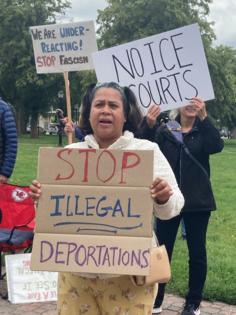Deported to El Salvador, Kansas City immigrant describes the violent ordeal: 'I lost everything'
Published in News & Features
Julio Rojas was 16 when he entered the United States from El Salvador back in 2016, presenting himself to authorities at the southern border in search of legal asylum, “because of the gangs,” he said.
He went to school for two years, found a girlfriend. She had legal residence, and they had a son, born an American citizen, who is now age seven. At 25 and six years into a job laying internet cable for companies like Verizon and AT&T, his life in Olathe was good.
Until it wasn’t. On Aug. 2, while on a Sunday errand to an auto parts store, he became one of the hundreds of thousands of immigrants in the U.S. who, since January, have found themselves arrested, detained and soon deported back to their home countries, swept up into the promise made by President Donald Trump on the path to his second presidency to conduct “the largest deportation operation in the history of our country.”
While photos and videos of arrests across the nation have become common, including last week on the streets of Lenexa, Kansas, the experiences of those arrested, detained and deported are rarely heard. On a Zoom video call from El Salvador, Rojas spoke to The Star and other local media regarding the violence of his arrest and the aftermath.
“It was really nice for me,” Rojas said of his life in Olathe, translated through a member of the Kansas City nonprofit Advocates for Immigrant Rights and Reconciliation. “I had a job. I could help my family, to help economically to my parents.
“But after the deportation, I lost everything: money, my family, my stability. And I think it damaged me psychologically and emotionally a lot.”
Waist chains, handcuffs, the question of excessive force
Nationwide, complaints have been rising over the purported use of excessive force by Immigration and Customs Enforcement (ICE) officers and other federal law enforcement at protests, in cities such as Portland, Oregon and Chicago, but also during detentions.
In Chicago, in October, journalists, nonprofits, unions and protestors joined together to sue the Trump administration for the alleged use of “extreme brutality” during the city’s protests. The suit includes the allegation that David Black, the senior pastor of the First Presbyterian Church of Chicago, was standing in the street “offering prayers and urging ICE officers stationed on the roof of the Broadview ICE facility to repent from their unnecessarily brutal enforcement of immigration laws,” when he was fired upon and struck repeatedly in the head by pepper balls.
“Moments later,” the suit contends, “he was sprayed in the face with tear gas by officers on the street.”
The American Civil Liberties Union this month decried a move by the Trump Administration to replace up to half of the leaders of ICE field offices across the country with U.S. Customs and Border Protection officers, an agency that it contends has been responsible for more than 200 deaths in the last 15 years, including 100 deaths from Border Patrol car chases.
“For months,” the ACLU wrote in a recent statement, “masked immigration agents have brought terror to communities across the U.S., arresting parents in carpool lines, dragging people into unmarked vans, threatening protestors, and arresting elected officials. So far, there has been no governmental accountability for these tactics. Instead, the Trump administration is ramping up enforcement by pulling in staff from an even more aggressive agency.”
Also in October, 11 Democratic U.S. Senators wrote a letter to Kristi Noem, the Secretary of Homeland Security, and the acting director of ICE, seeking greater transparency from ICE regarding deportation flights and policies that, they said, raised “serious human rights concerns.” Among them were the use of “handcuffs, waist chains,” as well, under certain conditions, “spit mask, mittens, leg braces, cargo straps, the WRAP,” which is a full-body restraint.
“A recent lawsuit,” the letter reads, “alleges that ICE put several detainees on a military cargo plane wearing straightjackets for 16 hours and did not tell them where they were going.”
The Star reached out for comments regarding purported harsh tactics from the Department of Homeland Security, Custom and Border Protection and ICE, but did not receive a response by the time of publication.
‘At no moment was I resisting’
Rojas said he recalled the day of his arrest well: being pursued by unmarked cars, having a gun drawn on him, being pressed to the ground with a knee against his neck.
He doesn’t know how ICE came to focus on him. He has no criminal record. Rojas said he pulled up to an auto parts store after 8 a.m. on that Sunday morning.
“Four trucks surrounded me,” he said. Unsure what was happening, he drove away. The trucks chased him. He pulled over.
“They wouldn’t stop following me and would try to make me crash,” he said.
As he got out of his truck, a Hispanic female officer tackled him and pressed him to the ground. Another agent appeared with his sidearm drawn.
“He was repeating, ‘Get the f*** on the ground!’ all the time, just yelling,” Rojas said. “All that I did was that I kneeled. I put my hands up. At no moment was I resisting. He came by and he hit me in the back. Then he put his knee on my neck.
“He picked me back up. The woman was the one that put me in the truck. In that moment I already had bruises (from) the hit I took to the ground.”
He said the officers brought him to the rear of a nearby store.
“Then they put chains on me. On my waist, on my feet, and on my hands,” he said. “That’s when this officer started saying, ‘We have caught another rat.’”
Rojas is quick to point out that, “in no moment did he ever read me my rights. . . At no moment did they present me with an arrest order, or a warrant. In no moment did they mention to me why they were arresting me. They just arrested me.”
Rojas, from that moment, would not appear in court, or speak to a judge.
‘He got the due process that he had been promised’
But Kansas City immigration attorney Michael Sharma-Crawford, who did not represent Rojas when he applied for asylum, said that based on Rojas’ narrative, it likely that the arrest and deportation, without being read one’s rights, was nonetheless legal.
Rojas said that when he first came to the U.S. in 2017, he applied for asylum and hired an attorney to represent him in federal immigration court. But when his case came before a judge, Rojas said, the attorney did not show. The judge issued an order of removal for Rojas’s deportation back to El Salvador.
Rojas hired another attorney to appeal the decision.
He maintains that it was only in August, when he contacted his original attorney to renew his legal work permit, that he discovered that his asylum had been turned down in 2019. He still had a pending order of removal.
“Once he got the live removal order, his options became really narrow,” Sharma-Crawford said. “If he came in at the border, filed for asylum, was ordered removed, and that was all procedurally correct, there’s not a lot of space there.”
He saw a judge. He case was adjudicated, appealed and denied.
“He got the due process that he had been promised,” Sharma-Crawford said.
He said that federal officers have lists of individuals with orders of removal. Once they are located, and arrested, there is no further need to go before a judge.
16 hours in handcuffs
Rojas was held for 21 days, first at the ICE detention facility near Kansas City International Airport, followed by detention in Wichita and Oklahoma City. Rojas’ son had his 7th birthday while Rojas was detained there. Finally, he was moved to the 400-bed, Alexandria Staging Facility, operated for ICE by the GEO Group.
“They moved us from Oklahoma to Louisiana, we were in handcuffs for 16 hours,” Rojas said.
Intended to house detainees for the short-term, no more than 72 hours, prior to deportation. Rojas was there for eight days.
“They gave us blankets and everything,” he said, “but, in two days, they took everything away because, supposedly, they were going to already deport us. Then they canceled everything. . .I was wearing the same thing for eight straight days.”
He said the drug K2, sometimes called “synthetic marijuana,” was rampant.
“I got sick the last three days, because the smell of the drugs they consumed was really, really strong,” he said. “They would burn it, and the smoke would go flying. . . There was no escaping it.”
Rojas was deported in late August.
“They took me out, and they chained me from my waist, my hand and my feet,” Rojas said. Once they entered Guatemalan airspace, they took off his restraints. He landed at the international airport in San Salvador.
Individuals on the plane who were wanted on criminal charges awaited the police. Rojas was first taken to a center for returning immigrants. Those without enough funds to return to their home communities were given money for their trips. Rojas returned to the town where his parents live.
“I have been two months without a job,” he said.
Meanwhile, his son remains in the Kansas City area, with his mother, who works during the day.
The high cost of justice
Rojas opted to share his story to help cast light on what he believes to be at least one federal agent in the Kansas City area who using excessive force in arrests, and to bring that agent, and perhaps others, to justice.
“Justice can be served in different ways,” Rojas said. “Many would like to see this officer behind bars. There has been a lot of abuse of power from his part. I think it’s time for him to pay up for his violence.”
Having a gun drawn on him, his neck pressed beneath the agent’s knee, Rojas said, “was the moment I was most afraid in my life.”
Getting that justice is not easy, said Kansas City immigration attorney Andrea Martinez. Generally, it involves suing in open court, which is generally an untenable proposition for immigrants who have been deported and are unlikely to bear the cost of a trial.
“I think that we, in the immigration lawyer community, would like to see more suits against ICE for these unlawful use of force cases,” Martinez said. “The problem is the expense of it. You have to have the money to sue ICE in federal court. You’re suing the deepest-pocket defendant in the world.
“You’re literally suing the United States of America with all of its resources. And they have all the taxpayer money for the best lawyers. Most people don’t have the money to be able to bankroll this on their own.”
Rojas, meanwhile, remains in El Salvador. His son is in school in Johnson County. His son’s mother works during the day. Once deported, it generally takes at least five years, sometimes as many as 10 or 20, before an individual is eligible again to legally reenter the U.S.
“My plan is to go back,” Rojas said, “in the most legal way possible.”
©2025 The Kansas City Star. Visit at kansascity.com. Distributed by Tribune Content Agency, LLC.










Comments